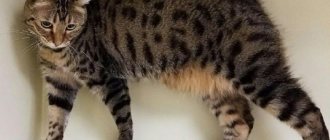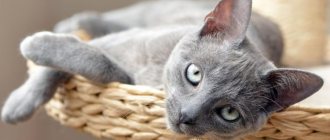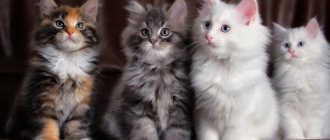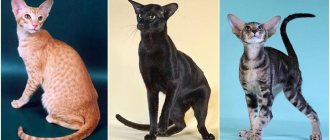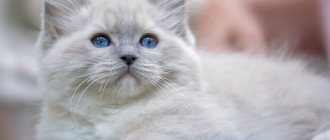There are several popular cat breeds that originate from Russia. For example, Russian blue cats are known all over the world, but the Ussuri cat rarely finds itself as a companion. Russian cat breeds differ both in appearance and in temperament, because they appeared in different parts of Russia from different ancestors.
10 Russian cat breeds
If you want to adopt a rare and unusual cat, it is better to first meet a representative of the breed. You will be able to understand how her character will fit with your lifestyle.
Kurilian Bobtail
The Kurilian Bobtail is a naturally occurring breed. These cats have lived for more than 200 years on Sakhalin Island and the Kamchatka Peninsula. They also live in the Kuril archipelago, connecting Russia and Japan. They look like predators, but in fact they are calm and affectionate. However, their instincts are well developed and they have high energy.
General characteristics
- HEIGHT : 23 – 30 cm
- WEIGHT : 4 – 8 kg
- APPEARANCE : soft, silky short to medium length coat; characteristic short tail; color red or gray with stripes
Features of breeding work in Russia
The new trend reached Russia with a long delay. The first association was created only in 1986. This date marked the beginning of the growth in popularity of Russian cat breeds, as not only our closest neighbors, but also countries very far from us began to learn about them.
Working methods
According to discovered chronicles, the first “mustaches” in Rus' appeared thanks to sailors in the 11th century. Due to the lack of interest in artificial crossing, new varieties developed independently - through free mating and natural selection.
INTERESTING!
Most Russian cats have a toponym in their name - the name of a geographical object. He points to the place of their origin.
World felinological organizations adhere to one of two methods of work:
- European. It is an association of amateur clubs. At exhibitions, judging is carried out in a closed format, excluding direct contact between judges and participants. After grading, the final decision is documented.
- American. It is an association of nursery owners. The examination of exhibition participants is carried out in a show format. Judges express their opinions publicly and are close to the audience. Drawing up a score sheet at the end of the event is acceptable, but not mandatory.
In Russia they are guided by European principles. For this reason, it is important to be a member of a club to participate in competitions.
Felinological organizations and their activities
Russian organizations followed the same path as England. Following the Felimur club, which organized the first exhibition of Russian cats in Moscow, the larger SFF, or Soviet Felinological Federation, was established in 1989. She united 14 cat clubs. After 2 years, she was accepted as a member of the WCF, registering under a new name - FAR, or Felinological Association of Russia.
Regardless of the size of the activity, all felinological organizations are engaged in the following tasks:
- They work through the basic subtleties of breed standards, trying to bring the characteristics specified in them to perfection.
- They systematize cat exhibitions and regulate the order of their holding.
- Standardize the rules for registering new breed varieties.
- They regulate the work of cat clubs and nurseries, and also monitor the correctness of its implementation.
- They are working on rules that control the work of felinologists - experts involved in cat shows and breeding new varieties.
Thus, in addition to consulting and issuing licenses to new clubs, the tasks of the FAR include representing their interests at the international level. With the help of this organization, breeders and felinologists constantly improve their professionalism by attending special internships and seminars.
Why are Russian cat breeds valued?
Russian cat breeds are valued for their uniqueness, beauty, short pedigree and high life expectancy. We have both unusual hairless sphinxes and curly rexes.
By default, both Neva Masquerade and Mekong Bobtails are beautiful, since blue eye color is very rare for the cat family. “Siberians” attract cat lovers from abroad with their good health, and bobtails with their wonderful short tail.
In addition to appearance, foreigners also note their extremely affectionate and devoted character. Most representatives resemble dogs in their devotion, which goes against the classic image of a stern Russian.
Ussuri
Ussuri have a strong and proportional body with developed muscles. The tabby's color ranges from golden brown to fawn. At the ends of the ears there are tufts like those of a lynx.
The average life expectancy of Ussuri cats is 12-16 years. By character they resemble wild ones, they are independent and freedom-loving. They need a lot of space, which will be their hunting territory. This breed is not suitable for communicating with children, as they do not like it when someone invades their territory.
Russian cat breeds recognized by felinological organizations
There are 10 cats that are recognized as Russian breeds. Among them you can find all 4 existing types of wool: curly, shorthaired, longhaired and hairless.
Russian blue
The representative with the most unusual history is the Russian Blue cat. It has been actively bred all over the world since the beginning of the 20th century, and in Russia only since perestroika.
This is explained by the fact that during her reign, Catherine II gave the English ambassadors several pets from Arkhangelsk - the ancestors of the modern Russian Blue. They marked the beginning of the natural formation of the breed in the conditions of their new homeland - Foggy Albion.
Russian Blues are excellent hunters who love to climb to the highest surfaces in the house. Because of this, they are often injured when falling out of the window.
“ More about the Russian Blue cat breed
Siberian
"Sibiryak" is the most famous Russian cat belonging to the indigenous varieties. Despite its long history, its targeted breeding began only in 1986. From that moment on, only the same fluffy and large pets with a similar exterior were allowed to be mated. After 5 years, the “Siberian” was accepted into the WCF.
These mustachioed pets are fearless, hardy and unpretentious. A country house is most suitable for keeping them, where animals can fully demonstrate their strength in catching rodents.
“ More about the Siberian cat breed
Neva Masquerade
The Neva Masquerade got its fluffiness and large size from the “Siberians”, and the history of the origin of its color causes a lot of controversy among felinologists. Some zealously support the “Persians” with similar colors, while others – the “Siamese”. WCF recognized the Neva Masquerade in 1992.
INTERESTING!
Most Neva Masquerade kittens are born white. Dark spots on their coat appear as they grow older.
Neva Masquerade is a typical aristocrat. She does not tolerate familiarity and familiarity from strangers, but in exceptional cases she allows this to the youngest members of the family.
“ More about the Neva Masquerade cat breed
Don Sphynx
The Don Sphynx appeared completely by accident. Its ancestor was found by a resident of Rostov-on-Don. The shabby and emaciated animal was attacked by local schoolchildren.
The found cat was rescued and taken to a new home, but after treatment her appearance never changed. Later, the cat gave birth to the same hairless offspring, and in 1997 her kittens were recognized by the WCF.
Don Sphynxes are not prone to aggression and jealousy, so they easily manage to find language with other pets. Like all other varieties, Donchak are distinguished by very high intelligence and are capable of remembering basic commands.
“ More about the Don Sphynx breed
Peterbald
Peterbald is the closest relative of the “Donchak”, obtained from his union with the “Oriental”. This cat is recognized by TICA and WCF as an emerging breed.
Peterbalds are very sociable and good-natured pets who strive to give their love to everyone around them. Being too open with their feelings can make them seem a little meticulous, especially to those who have a strong need for personal space.
Kurilian Bobtail
According to felinologists, fluffy “short-tailed” cats appeared as a result of natural crossing of “Siberians” and Japanese bobtails. The former came to the Kuril Islands along with settlers, and the latter as part of Japanese military and research expeditions.
Due to the harsh climate, the new variety acquired two features: large size and lack of fear of water. “Kurilets” entered the FIFe standards in 2004.
INTERESTING!
Kurilian Bobtails do not know how to remove their claws. This makes them look longer compared to other cats' claws.
“Kurilians” get along well with other pets and get along well with children. Due to their increased activity, they should be kept in a country house with the possibility of free walking in the fresh air.
“ More about the Kurilian Bobtail breed
Karelian Bobtail
This fluffy aboriginal cat was discovered near Lake Ladoga. For some time he was classified as a Kurilian Bobtail, but a genetic test showed no relationship. In 1994, the cat was registered with WCF.
Karelian “short-tailed dogs” are independent and freedom-loving. Unlike affectionate sphinxes, they rarely sit on hands, but they also appreciate the attention of their owner. These cats are also characterized by increased playfulness, which persists into old age.
Ural rex
The Ural Rex is the result of an unknown genetic mutation. The first individuals with curly fur were noticed in the Urals in the 1920s, but their active breeding began only in 1988. In 2006, the Ural Rex standard was approved by the WCF.
These cats are affectionate and playful. They are well trained in fetching toys and are very kind to kids. Also, Ural rexes have a developed hunting instinct, so it is better for owners of budgies and hamsters to choose someone more peaceful.
Mekong (Thai) Bobtail
Despite the exotic name, the Mekong Bobtail standard was developed in 1994 in St. Petersburg. Because of this, he was assigned Russian origin. In fact, the ancestors of these cats came from Southeast Asia, where the Mekong River flows.
With a typical Siamese appearance, short-tailed bobtails are renowned for their curiosity, sociability and canine-like habits. They constantly strive to study and comment on everything, and are also happy to carry out the “Fetch” command.
Skiff-toy-bob
Another representative from Rostov-on-Don was accepted as an experimental one. Of the large organizations, it is recognized by TICA.
The skiff-toy-bob came about completely by accident. The first kitten was born from a pair of Mekong Bobtails. The baby differed from its parents in its more modest size. At 1.5 years old, he weighed as much as a 4-month-old kitten.
INTERESTING!
Skif-toy-bob is used in canistherapy to help sick children.
Scythian beans are very attached to people and constantly try to be close to their owners. Their hunting instinct is poorly developed, so breeders allow cats to be kept together with birds and rodents.
Cats are odorless and prone to shedding
There is a joke that in a house where a cat lives, wool is a seasoning. In fact, a constantly shedding pet causes a lot of trouble for its owners.
To avoid constant cleaning and daily combing, it is worth getting a cat of a breed that is not particularly shaggy.
Hairless cats, Lycois and all kinds of rexes are an ideal option for owners who do not want to bother with fluff. In addition, these animals produce almost no sebum and secretions, which cause a specific “cat” smell.
Among the breeds with short fur, there are those that shed infrequently. These are Bengals, Siamese, Orientals and Abyssinians. Short-haired species, whose ancestors lived and were bred in Asia, shed little hair and have practically no smell.
Also read about cat breeds that don't shed.
Ural rex
The Ural Rex is a breed with a rather unusual appearance. The peculiarity of cats is long wavy hair. The muzzle is slightly elongated, with well-defined cheekbones and a strong chin. Eye color always matches the main color.
In addition to their original appearance, the Ural Rex also has an interesting character. They are not picky, easy to train, and get along well with people and animals. And their fur does not cause allergies.
Petersburg Sphinx, or Peterbald
Another breed with an exotic appearance. These cats have a completely naked body without a single hair, huge ears, thin and long legs and a tail. Despite their very specific appearance, they are very popular. Peterbalds have a wonderful character.
They:
- playful;
- smart;
- loyal to owners;
- friendly towards both people and animals.
St. Petersburg Sphynxes love children. They allow themselves to be stroked and picked up. They treat all family members equally well.
Diseases
Since many breeds arose naturally, they are resistant to disease and even harsh climates. Most diseases can be prevented by preventive measures: vaccination, examination by a veterinarian. Antiparasitic drugs should be given at least once a year, even if the pet lives in the house. After walks in the warm season, it is necessary to inspect to ensure there are no ticks.
There may also be external parasites: fleas, lice eaters, ear mites. Special collars and drops help. Hypothermia should not be allowed, even if cats are cold-resistant. This can cause kidney inflammation.
Toy bob
Toy beans were first seen in Russia in the 1980s. These animals were bred as a result of a genetic mutation. A cat with a short, curved tail was crossed with a bobtail cat, resulting in an unusually small kitten with a short tail.
Toy Bobs can always remain the size of an average kitten, but they have quite a difficult character. This pet loves to play and is quite active, but at the same time he really enjoys spending time on his owner's lap.
Unique strains of bacteria from the ISS are used in terrestrial crop production
A masterpiece of evolution: giraffes can help people suffering from hypertension
Actress twin sisters Arntgolts became mothers 20 days apart
Neva Masquerade
A young breed that was bred only at the end of the last century. It received its name from its place of origin (St. Petersburg) and because of its color characteristics. Dark hairs grow on the face, reminiscent of a masquerade mask. These cats have very thick and long hair. Especially lush on the chest, tail and hind legs.
Neva Masquerade Dogs are distinguished not only by their beautiful appearance, but also by their wonderful character. They:
- sociable;
- unobtrusive;
- smart;
- loyal to their owners;
- absolutely unforgiving.
Thanks to their high level of intelligence, cats quickly get used to their name. Having remembered the nickname, they do not respond to any other calls, especially from strangers. Neva Masquerade Dogs are very friendly. They get along well with other pets - cats or dogs.
How to choose
Several recommendations can help you make your choice:
- Decide on the breed: what appearance, character, behavior is attractive.
- Take into account the conditions of detention, the tendency to allergies.
- Select the gender of the kitten: boy or girl.
- Choose where to get a kitten: from a breeder, a nursery or a shelter.
A purebred animal must have pedigree documents, metrics, and a passport from a veterinarian. It is necessary to draw up a purchase and sale agreement.
It is better not to rush to take a kitten at a young age from its mother cat. An underfed pet will have weak immunity and reduced resistance to disease. At the age of 1 month it is just beginning to form. The kitten learns the necessary skills from its mother and learns to be independent. The optimal age when you need to pick up a kitten is from 3 months.
You need to evaluate your pet's health. The kitten must be inquisitive, active, and responsive to games. It is necessary to check the hearing, determining how it reacts to sounds, especially in white kittens. Other indicators:
- The eyes are not tearful.
- The nose is cold.
- The inside of the mouth is pink, the teeth are in place.
- The ears are clean and free of discharge.
Interesting! A healthy kitten has shiny fur without bald spots or wounds.

